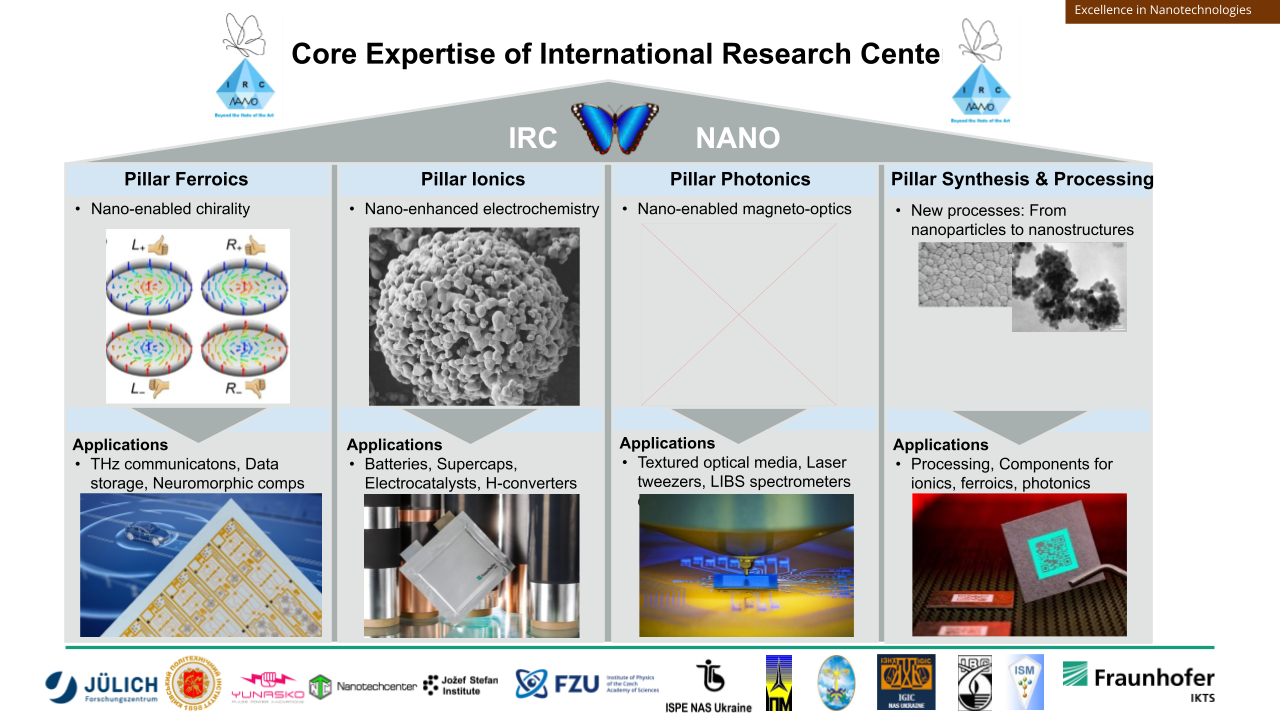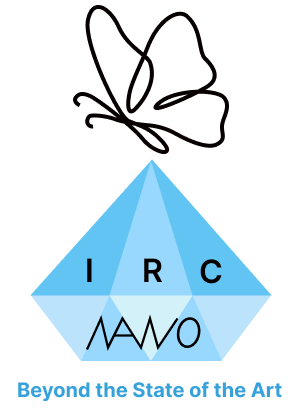Research areas
The scientific structure of IRC NANO is grounded on the mostly developed research avenue of Ukrainian material science, synthesis and processing of the advanced nanomaterials and, on the initial implementation stage is organized in four research pillars. These pillars are strongly connected with industrial applications in the most demanded areas such as energy, computing and telecommunication.

Each pillar contains projects, selected according to the emergent quests of Society. Importantly, in the long-term perspective these pillars and projects can be transformed, modified and even replaced by the more appealing directions, according to those acquired by the Centre projects. However, the transversal pillar, “Synthesis and Processing”, will stay intact, adopting the types of materials and methods of synthesis in line with projects’ needs. Such structure enables the stability and great flexibility of the IRC NANO in mid- and long-term approach. Table below presents strategic objectives, foreseen impact and means of their achievement.
- Pillar CX: Synthesis and Processing
The excellence in science under this foundational IRC NANO’s pillar will be achieved via systematic studies of the phenomena inherent in synthesis, self-assembly, assembly and sintering by computer code of simple and complex nanostructures from nanoparticles and their clusters / polymers, revealing the mechanisms of synthesis of nanostructures, their kinetic competition under external fields and search for correlations between synthesis/consolidation parameters and resulting nanostructures. The targeted nanoparticles and prepared from them nanostructures will be created in accordance with the requirements and/or theoretical predictions of the Ferroics, Photonics and Ionics properties. Most of the processes will be brought to the laboratory scale level TRL 4, but the possibilities of their further scaling and commercialization will be shown for applied research and industrial partners. Our unique rate-controlled synthesis process, which provides an efficient feedback loop to control particle shape and size, will be used. It has been scaled up and commercialized by a partner company. Special techniques such as reaction on templates or bioinspired preparation will be applied for synthesis of the chiral nanoparticles requested from ionics, ferroics and photonics areas.
Further development of the cold sintering (CSP) taking into account the rate controlled mode, self-assembly technique, including alignment under magnetic field will provide a wide range of technologies for obtaining high-density and textured ceramic nanomaterials, hybrid nanocomposites, highly porous (up to 90%) regular structures-energy converters – all at extremely low temperatures, <350°C, using liquid-phase material transport. Innovative cold sintering with a controlled shrinkage rate will become a key enabling technology in the production of ceramics and composite ceramic/polymer materials.
- Pillar IX: Ionics
In recent years, the world has seen the rise of new battery technologies, in particular, in the hybrid and electric vehicle industry. Further progress in this area will obviously be related with “beyond lithium” technologies to meet the challenging requirements of improving the raw material resilience, safety, fast charging, extended cycle life, expanded operation temperature range, etc. In line with these new trends, the technologies of promising electrodes, jelly-like or polymer ion-conducting electrolytes, and corresponding mechanisms enabling faster charge transfer processes in hybrid electrochemical systems including the fast ion transport in jelly-like, polymer or solid electrolytes will be explored.
- Pillar FX: Ferroics
Modern micro- and optoelectronics are currently facing a profound challenge. The demand for smaller, faster, and more efficient devices has reached the ultimate technological limit. In pillar “Ferroics” we propose a non-incremental solution based on the use of ferroelectrics, a class of materials that are electrically polarized. We devise the long-term strategy of exploration of the emergent properties of the topological structuring of ferroelectrics, suggesting innovative R&D avenues, to name a few: tunable chirality for optoelectronic, biochemistry and quantum information processing, THz vibrations for ultrafast nanoelectronics, the negative capacitance for low-dissipative nanoelectronics, and multilevel logic unit for non-von Neumann & neuromorphic computing. The expected research, industrial, and societal impacts are overwhelming. They extend from nanoelectronics, optoelectronics, and plasmonics, to quantum information processing and biomedical and pharmaceutical applications.
- Pillar PX: Photonics
The nanophotonics-based engineering of light / matter interactions is implemented on subwavelength scales. IRC NANO is eager to deliver in the mid- and long-term perspective our fresh ideas in nanophotonics, grounding on the paradigm exploring synergy of the soft- and hard- bounding of matter to get top level of properties. Assembling the optically active laser matrices from monocrystalline nanoparticles by their alignment under magnetic field occurs due to soft bonding of the particles. The following sintering allows hard bonding of particles in poreless highly transparent textured components to be manufactured. These leading-edge approaches will be applied in the project to meaningfully improve efficiency of the anisotropic laser matrices and their quantum yield. Further steps will be addressed to application of laser tweezers in the process of assembling nanostructures from nanoparticles. Emergent cold sintering techniques should bring us the proof of concept for nanomanufacturing of optical grade components. The photocatalytic efforts will be focused on nanomaterials providing green technology of hydrogen splitting from water or alcohols and inactivation of harmful bacteria, viruses and organics in the environment.
